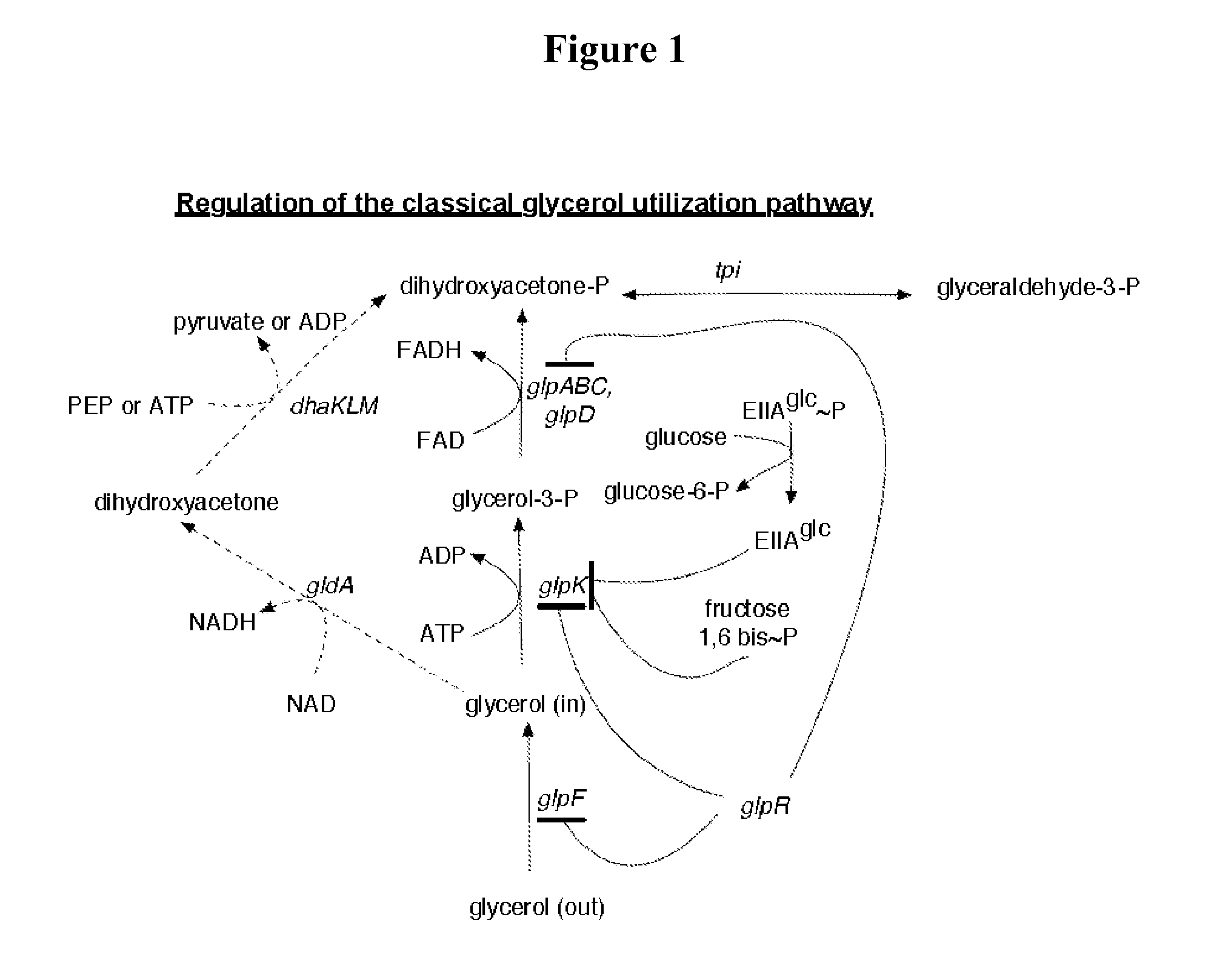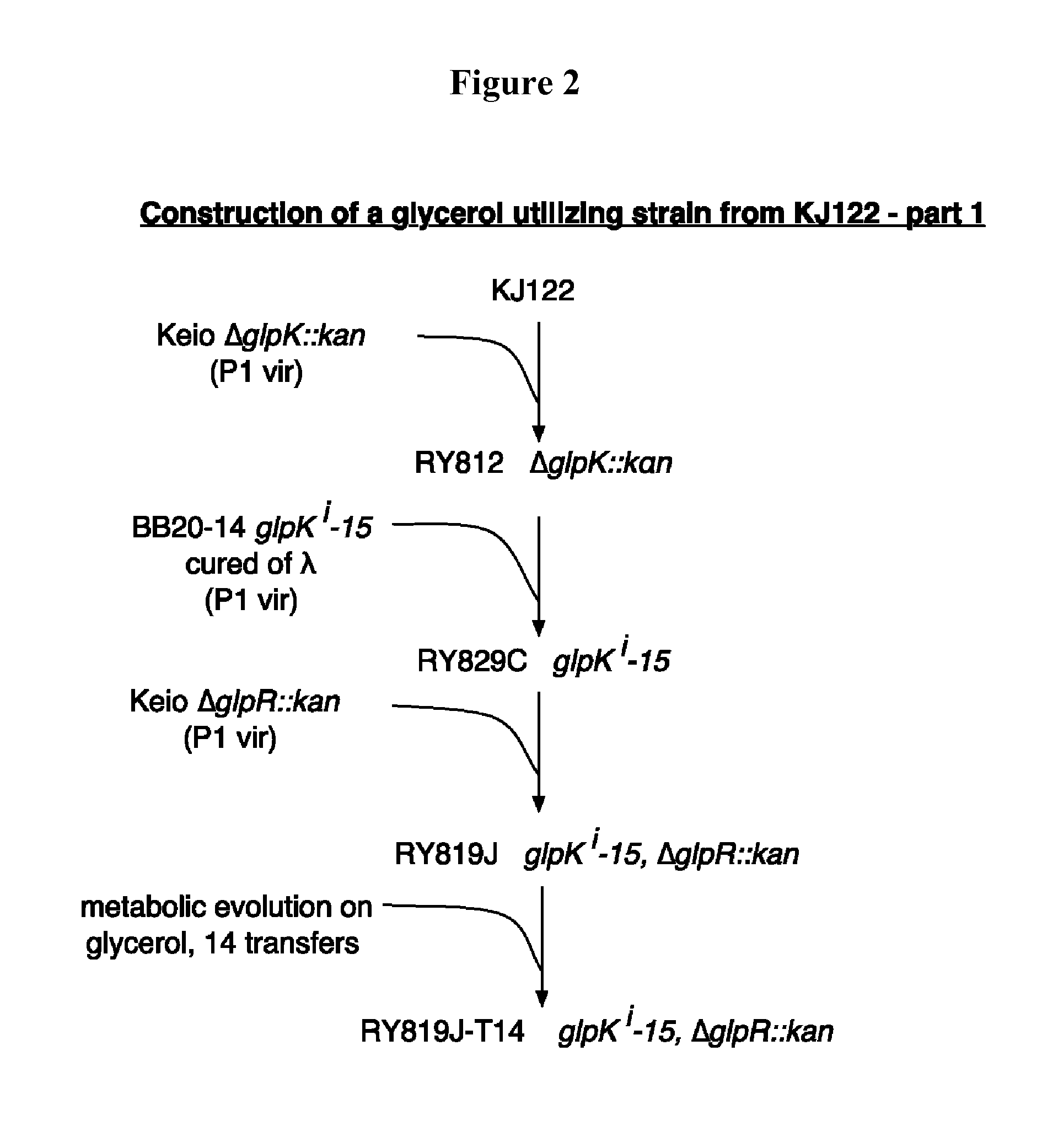Fermentation of glycerol to organic acids
a technology of organic acids and glycerol, which is applied in the direction of peptides, enzymology, microorganisms, etc., can solve the problems of industrial microorganisms that cannot use glycerol as a feedstock, industrial microorganisms that cannot use glycerol as a commercial feedstock, and undesirable for large-scale fermentation
- Summary
- Abstract
- Description
- Claims
- Application Information
AI Technical Summary
Benefits of technology
Problems solved by technology
Method used
Image
Examples
example 1
Removal of Negative Regulation of Glycerol Uptake and Utilization in Strain KJ122
[0076]Three different minimal media can be used for plate selections of bacterial strains, for succinate production in test tubes, or for succinate production in pH controlled fermentors. The minimal media are listed in Table 1. Rich broth or plates were Luria Broth, also known as “LB” (10 g / l tryptone, 5 g / l yeast extract, 5 g / l sodium chloride). The following strains were obtained from the Coli Genetic Stock Center (CGSC), Yale University, New Haven, Conn.: JW 3386-1 (ΔglpR::kan) and JW 3897-1 (ΔglpK::kan). Using generalized phage transduction with P1vir, the ΔglpK::kan allele from JW 3897-1 was installed in KJ122, selecting for kanamycin resistance using 50 mg / l kanamycin sulfate in LB plus 25 mM sodium citrate, and confirming correct installation of ΔglpK::kan by lack of growth on minimal plates with glycerol as the sole carbon source (FIG. 2). The resulting strain was named RY812. In parallel, the ...
example 2
Production of Succinate from Glycerol in Test Tubes
[0077]Strains KJ122 and RY819J were grown overnight aerobically in Luria Broth and then inoculated to give 0.05 OD600 in 12.5 ml of NBS medium containing 20 g / l glycerol in 15 ml polypropylene test tubes with screw caps. The tubes were capped tightly and rolled on a New Brunswick Scientific roller drum at 37° C. at about 60 rpm for 48 hours. Culture samples were prepared by removing cells by centrifugation through Costar spin filters, diluted as necessary in 0.008M sulfuric acid, and analyzed by high pressure liquid chromatography (HPLC) using an Agilent Model 1200 apparatus installed with a BioRad Aminex HPX-87H column. The column was run at 50° C., with 0.008 M sulfuric acid as the solvent, and the detection was by both refractive index and absorption at 210 nm. Samples were analyzed for concentration of succinic acid, glycerol, glucose, acetate, and other byproducts. Concentrations of each chemical were calculated using standard ...
example 3
Metabolic Evolution of RY819J
[0078]Strain RY819J was grown overnight aerobically in NBS medium containing 10 g / l glucose and 10 g / l glycerol, and then inoculated into a 500 ml working volume covered fermentor containing 300 ml of AM1 medium (see Table 1) containing 50 g / l glycerol and 50 g / l glucose, to give a starting OD600 of 0.2. The fermentor was stirred with a magnetic stirrer at 150 rpm, but no deliberate aeration was supplied. As such, the fermentor was not strictly anaerobic, since some air is admitted during sampling and from base addition. The pH was controlled at 6.5 by addition of 3M potassium carbonate, and the temperature was maintained at 40° C. Succinate was produced for about 48 hours, and glycerol and glucose were consumed in parallel, but after 48 hours, a portion of the glycerol remained. The final cell density was about 3.0 OD600. A sample from the first fermentor was used to inoculate a second fermentor to a starting OD600 of 0.2, using the same medium, and gro...
PUM
| Property | Measurement | Unit |
|---|---|---|
| Mass | aaaaa | aaaaa |
| Volume | aaaaa | aaaaa |
| Volume | aaaaa | aaaaa |
Abstract
Description
Claims
Application Information
 Login to View More
Login to View More - R&D
- Intellectual Property
- Life Sciences
- Materials
- Tech Scout
- Unparalleled Data Quality
- Higher Quality Content
- 60% Fewer Hallucinations
Browse by: Latest US Patents, China's latest patents, Technical Efficacy Thesaurus, Application Domain, Technology Topic, Popular Technical Reports.
© 2025 PatSnap. All rights reserved.Legal|Privacy policy|Modern Slavery Act Transparency Statement|Sitemap|About US| Contact US: help@patsnap.com



